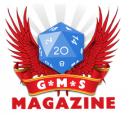Author: Tim Gray
Published by Silver Branch Games
Centuries ago, the years of ecological abuse came to a head. Stories say that Gaia,Mother Earth, caused the sea to rise, the ground tremble and the climate change in extraordinary ways. Society crumbled and in it’s place arose the Druid Order.
Now, in the realm of Albion, peace and prosperity have come, the technology that brought upon the Age of Madness has gone but rumours of a growing darkness have begun to spread…
The background of this new RPG is fascinating; think Robin of Sherwood meets Survivors with a dash of Warhammer 40k and Fallout thrown in. The Druid Order who maintain the peace could be seen as kindly parents, guiding society, or a brutal, authoritarian group, who punish those who wish to learn more of Albion’s past and the technological marvels it possessed.
Yes, some relics of the past do exist but they are rare; the magic items of this setting, maybe. But, their use is strictly forbidden by the Druids… In general, life in Albion is similar Celtic Britain with it’s Druids, Bards and mythical trappings. There are towns and settlements, ruled over by town leaders who in turn answer to the King, of which, there are many. But guiding most are the Druid Order..
Well, enough of the setting, what about the rules?
Basics
 As in most RPGs, characters have a set of attributes, in this case, seven as opposed to six. Good old DEX has been split into Agility and Deftness. One is movement based and the other is hand-eye coordination. Personally, I couldn’t see the point of splitting these but more on that later.
As in most RPGs, characters have a set of attributes, in this case, seven as opposed to six. Good old DEX has been split into Agility and Deftness. One is movement based and the other is hand-eye coordination. Personally, I couldn’t see the point of splitting these but more on that later.
Then there are the Skills. These are normally chosen as you create your character, figuring where he/she came from and their occupation.
Tasks are performed by adding the relevant attribute to a skill and rolling a number of D6s equal to the total. 4, 5 and 6 are successes, with 6 being an impressive success, allowing you to roll another die. However, roll roll all 1s and bad stuff happens. We leave that to the GM’s imagination..
Die can be taken from a player’s die pool for more difficult tasks, player injuries or the metaphysical force known as Blessing or Curses. Yes, there is Magic in Albion…
Magic
Magic is split into two types: Spirit and World.
Spirit comes from within whilst World is the manipulation of the strands of the Web that covers the land.
To cast spells, characters add the relevant attribute to their Art, Spirit or World Magic Skill then rolls that number of die, much like performing any task. But casting magic may fatigue the character, making them less proficient to perform other tasks for a short time.
Players can buy a few spells in the character creation process, normally if they follow certain career paths such as the Druid, Priest or Magican but may learn more as they progress.
There plenty of spells of spells to choose from and leave plenty of room for Roleplaying opportunities.
Combat is reasonably simple: rounds are broken into 10 sections. Everyone rolls a d6 and adds their initiative modifier then the GM counts down from 10 to 1 and everyone gets to act when their number is called.
Using a mixture of Attribute, Weapon and Skill, attackers get a number of die which they roll and they have to get a number of successes equal to or more than the defender’s Defense. Damage can take the form of reducing the characters initiative, number of die in their pool, knocking them unconscious or even killing them.
Overview
Well, there is plenty more in this book, such as different equipment, everyday life in Albion, Fire and Destiny points that gain aid players. (Action points, basically!) and a small bestiary containing all kinds of horrors from Celtic mythology. Some of these can even be used as Player Characters.
There are factions, geography,some example NPCs, a small adventure and a two page GM’s reference sheet at the back of the book.
This 260 page hardback book has a wealth of information. There are plenty of black and white illustrations within, just not enough. The layout is okay but I wish the creatures had each gotten a page of their own; some spread over pages, so a GM would have to keep flicking back and forth.
Having been over the rules several times, they are relatively simple though there are plenty of modifiers which at times seem to over-complicate things. The proof would be in the play, but I feel early games would involve too much page turning. The joy of the D20 system was that players and GMs both had a point of reference to work from whereas learning a new system can be daunting.
I am from the rules-lite, Roleplaying- heavy school and found some of Albion a bit ‘crunchy’.
However, I rather like the setting which has just right mix of fantasy with a sprinkle of modern day. I wouldn’t mind running a few sessions though I don’t think it could maintain my interest for a long-term campaign.
Congratulations to Tim Gray for creating an interesting setting and I would recommend people at least take some time to explore the world of Albion.
You can buy Albion at:
 |  |
 |


